Where Is the City of Arts and Sciences Waht City Is It in
| Valencian: Ciutat de les Arts i les Ciències | |
| Spanish: Ciudad de las Artes y las Ciencias | |
 Aeriform view (2009) | |
 | |
| Location | Valencia, Kingdom of spain |
|---|---|
| Coordinates | 39°27′15″North 00°21′00″West / 39.45417°Due north 0.35000°W / 39.45417; -0.35000 Coordinates: 39°27′15″Northward 00°21′00″Westward / 39.45417°N 0.35000°W / 39.45417; -0.35000 |
| Owner | Ciudad de las Artes y las Ciencias, Southward.A. (CACSA) |
| Structure | |
| Opened | Fifty'Hemisfèric (1998), Museu de les Ciències Príncipe Felipe (2000), L'Umbracle (2001), L'Oceanogràfic (2003), Palau de les Arts Reina Sofía (2005), Montolivet Bridge (2007), Assut de fifty'Or Bridge (2008), L'Àgora (2009) |
| Construction cost | i,200 one thousand thousand euros |
| Builder | Santiago Calatrava, Félix Candela (50'Oceanogràfic) |
| Website | |
| www | |
The City of Arts and Sciences (Valencian: Ciutat de les Arts i les Ciències [siwˈtad de les ˈaɾts i les siˈɛnsi.es]; Spanish: Ciudad de las Artes y las Ciencias [θjuˈðað de las ˈartes i las ˈθjenθjas]) is a cultural and architectural complex in the city of Valencia, Kingdom of spain. Information technology is the most of import modern tourist destination in the urban center of Valencia and one of the 12 Treasures of Spain.
The Metropolis of Arts and Sciences is situated at the southeast end of the sometime riverbed of the river Turia, which was drained and rerouted after a catastrophic flood in 1957. The old riverbed was turned into a picturesque sunken park.
Designed by Santiago Calatrava and Félix Candela, the project began the outset stages of structure in July 1996, and was inaugurated on xvi April 1998 with the opening of Fifty'Hemisfèric. The concluding major component of the City of Arts and Sciences, Palau de les Arts Reina Sofía, was inaugurated on 9 October 2005, Valencian Community Day. The almost recent edifice in the complex, L'Àgora, was opened in 2009.[1]
Originally budgeted at €300 meg in 1991 for three structures, information technology has expanded about three times the initial expected cost.[two]
Buildings and structures [edit]
The complex is made up of the following buildings and structures, presented in the order of their inauguration:

- Fifty'Hemisfèric (1998) – an IMAX Picture palace, planetarium and laserium. The building is meant to resemble a giant eye, and has an approximate surface of thirteen,000 k². The Hemisfèric, also known as the planetarium or the "eye of knowledge", is the centerpiece of the Urban center of Arts and Sciences. It was the outset building completed in 1998. Its design resembles an eyelid that opens to access the surrounding h2o pool. The bottom of the pool is glass, creating the illusion of the eye every bit a whole. This planetarium is a half-sphere in a physical structure 110 meters long and 55.5 meters wide. The shutter is built of elongated aluminum awnings that fold upward collectively to course a brise soleil roof that opens forth the curved centrality of the heart. It opens to reveal the dome, the "iris" of the eye, which is the planetarium or Ominax theater. The structure is divided in one-half by a set of stairs that descend into the vaulted concrete entrance hall. The cloak-and-dagger spaces are illuminated with the utilize of translucent drinking glass panels within the walking path. The transparent roof is supported past concrete arches that connect to the sunken gallery. At that place is a remarkable echo in the building and if two people stand at the ii opposite pillars inside of the eye they tin can speak with each other.

Museo de las Ciencias Príncipe Felipe
- Museu de les Ciències Príncipe Felipe (2000) – an interactive museum of scientific discipline that resembles the skeleton of a whale. Information technology occupies around 40,000 1000² on three floors. Much of the basis floor is taken up past a basketball courtroom sponsored by a local team and various companies. The building has three floors, of which 26,000 foursquare meters is used for exhibitions. The first flooring has a view of the Turia Garden that surrounds it, which is over 13,500 square meters of water. The second floor hosts "The Legacy of Science" exhibition by researchers Santiago Ramón y Cajal and Severo Ochoa y Jean Dausset. The third flooring is known as the "Chromosome Forest" and shows the sequencing of human Deoxyribonucleic acid. Too on this floor are the "Zero Gravity," "Space Academy" and "Curiosity Superheroes" exhibitions. The building's compages is known for its geometry, structure, use of materials, and its design effectually nature. The building is about 42,000 square meters, of which 26,000 square meters is exhibition space, making it the largest in Spain. Information technology has twenty,000 square meters of drinking glass, four,000 panes, 58,000 m³ of physical, and 14.000 tons of steel. The building stands 220 meters long, 80 meters wide and 55 meters high.

- Fifty'Umbracle (2001) – an open up structure enveloping a landscaped walk with plant species ethnic to Valencia (such as rockrose, lentisca, rosemary, lavender, honeysuckle, bougainvillea and palm trees). It harbors in its interior The Walk of the Sculptures, an outdoor art gallery with sculptures by contemporary artists (Miquel de Navarre, Francesc Abbot, Yoko Ono and others). The Umbracle is as well domicile to numerous free-standing sculptures surrounded by nature. It was designed as an entrance to the Urban center of Arts and Sciences. It is 320 meters long and 60 meters wide, located on the southern side of the complex. It includes 55 fixed arches and 54 floating arches that stand 18 meters loftier. The plants displayed were advisedly picked to alter colour with each season. The garden includes 99 palm trees, 78 small palm trees, and 62 bitter orange trees. There are 42 varieties of shrubs from the Region of Valencia including cistuses, mastics, buddleia, pampas grass, and plumbagos. In the garden at that place are sixteen species of Mirabilis jalapa, or the four-o'clock flower ("beauty of the dark"). Honeysuckle and hanging bougainvillea are 2 of the 450 climbing plants in L'Umbracle. At that place besides are v,500 ground comprehend plants such as lotus, agatea, Spanish Flags, and fig-marigolds. In that location are over a hundred aromatic plants including rosemary and lavender.
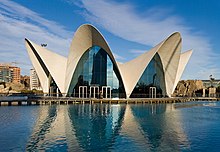
- L'Oceanogràfic (2003) – an open-air oceanographic park. It is the largest oceanographic aquarium in Europe with 110,000 square meters and 42 one thousand thousand liters of water. It was built in the shape of a h2o lily and is the piece of work of architect Félix Candela. Each building represents different aquatic environments including the Mediterranean, wetlands, temperate and tropical seas, the Antarctic, the Chill, islands and the Blood-red Bounding main. This aquarium is a home to over 500 different species including dolphins, belugas, sawfish, jellyfish, starfish, sea urchins, walruses, sea lions, seals, penguins, turtles, sharks and rays. It also houses wetland bird species.

- Palau de les Arts Reina Sofía (2005) – an opera house and performing arts center defended to music and the performing arts. It is surrounded past 87,000 square meters of landscape and h2o, as well as ten,000 foursquare meters of walking area. The Palau de Les Arts has four sections: the principal hall, the principal hall, the auditorium, and the Martin y Soler theatre. Information technology holds many events such every bit opera, theatre and music in its auditoriums. Panoramic lifts and stairways connect platforms at dissimilar heights on the inside of the metallic frames of the building. The edifice has a metallic feather outer roof that is 230 meters long and lxx meters loftier. The building is supported by white concrete. 2 laminated steel shells cover the building, weighing over 3,000 tons. These shells are 163 meters broad and 163 meters long.

Montolivet Span, newer southern segment
- Montolivet Bridge (2007) - concrete road bridge crossing the dry Turia riverbed that consists of an older straight-roadway northern segment with column piers designed by Fernández Ordóñez (1933-2000)[three] connected with a newer curved-roadway southern segment with white arch point supports designed by Santiago Calatrava,[iv] located in between, and complementing his pattern of, Palua de les Arts Reina Sofía and 50'Hemisferic.

- Assut de fifty'Or Bridge (2008) – a white cablevision-stayed bridge sustained by a curved pylon with backstayed counterweights, crossing the dry Turia riverbed, connecting the south side with Minorca Street, in between El Museu de les Ciències and Fifty'Agora. The pylon of the bridge, at 125 meters loftier, is the highest point in the city.

- Fifty'Àgora (2009) – a covered plaza in which concerts and sporting events (such every bit the Valencia Open 500) are held.[ane] The Agora is a space designed to hold a multifariousness of events such equally concerts, performances, exhibitions, conventions, staging of congresses, and international sports meetings. Many important events take been held in this edifice, including the Freestyle Burn Castilian Cup in 2010 and the Christmas Special Program.
- Valencia Towers – office of a Calatrava project (2005) to complete the Metropolis of Arts and Sciences with the additional construction, then estimated to take more than two decades to complete, of three sculptural towers of 308, 266 and 220 grand tall, which symbolize the cities of Valencia, Alicante and Castellón, respectively. The proposed projection has been put on hold.[5]
History [edit]
Origins of the project [edit]
In 1989, the president of the Valencian Autonomous Government, Joan Lerma, subsequently a visit to the new Cité des Sciences et de l'Industrie in Paris, and through the general director of planning and studies of the Presidency of the Generalitat Valenciana, Dr. José María Bernabé, officially commissioned the scientist Dr. Antonio 10 Ros to draft a first proposal for a City of Science and Technology for Valencia.[6]
Dr. Ten Ros drew up a first draft, entitled "Vilanova, A City of Scientific discipline for Valencia", which was officially presented to the Generalitat in May 1989. After that, he was formally commissioned in 1990 to direct the creation of a general typhoon amounting to 92,650,000 pesetas (556,000 euros), to be managed past the University of Valencia. Antonio 10 Ros assembled a squad of 56 scientists, museologists and designers including Professor José María López Piñero every bit responsible for the space "A walk through history". Ten Ros presented the typhoon in 32 volumes to President Lerma in the Palace of the Generalitat on 21 December 1991.[6]
The "City of Science and Communications" was the proper noun that the democratic government gave to the initiative, and plans included a 370m loftier communications belfry, which would take been the third highest one in the world at that time; a planetarium; and a museum of scientific discipline. The total cost of the works was estimated to exist about 25,000 meg pesetas.
In May 1991, the council approved the transfer of lands. Four months later on the projection plan with three structures (communications belfry, planetarium, and a scientific discipline museum) was presented, designed past Santiago Calatrava.[7]
The squad that had designed the museum did not come across heart to eye with the grade in which Santiago Calatrava conceived the building, and a couple of changes were made. Preliminary site work began past the end of 1994.[7]
The project was not without controversy. The Bourgeois Popular Party saw in the City of Science a "work of the pharaohs" that would serve merely to corking the ego of the Socialists, who were the driving forces behind the initiative.[eight]
Expanded plan and construction [edit]

Plan: longitudinal axis bisects Palau de les Arts Reina Sofía, Montolivet Bridge, L'Hemisferic, and extends through L'Agora to L'Oceanografic
In 1995, the Popular Party won against the Socialists. However, several successive Popular Party governments connected and expanded the complex far beyond the original Socialist project at an enormous cost, heavily indebting the city.[eight] [9]
Subsequently a modify of regime in 1996, the planned telecommunications tower was cancelled and replaced past an opera house,[10] which was more expensive, and architect Félix Candela was added to design an oceanographic park,[xi] all of which led to underspecified increases in the project budget and to updating the name to City of Arts and Sciences. In July 1996, the original Valencia, Ciencia y Comunicaciones was officially changed to Ciudad de las Artes y las Ciencias, S.A. (CACSA).[12] Structure on the City of Arts and Sciences under CACSA began July 1996. When structure started in 1997 on the Palau de les Arts, information technology was built with the same foundation and the same contract that had been planned for the cancelled communications tower.[9]
The revised plan (by Calatrava) exhibited a strong longitudinal centrality that defined the backbone tying together all the structures of the circuitous. It bisected the Opera House, Montolivet Bridge, L'Hemisferic, and extended through the Assut de L'Or Bridge and L'Agora (commissioned subsequently in 2005) to L'Oceanografic (designed by Candela). Parallel to the centrality were placed the science museum, 50'Umbracle, raised promenades and reflecting pools.[xiii] [xiv]
As the site is close to the body of water, and Valencia is and then dry, I decided to make water a major chemical element for the whole site using it as a mirror for the architecture. --Santiago Calatrava[ten]
Another unifying element was the use of the metropolis'due south traditional heritage, viz., the use of ceramic mosaic tiles known as "trencadis", which was widely used as the exterior layer over the concrete surfaces of many of the buildings/structures and elements of the promenade throughout the circuitous.[14]
Structure continued on the site until the last structure, Fifty'Agora, was completed in 2009. The total cost of the project came in at 1,200 meg euros.[15]
Inauguration [edit]

Logo: Ciutat de les Arts i les Ciències
In Apr 1998, the complex opened its doors to the public with L'Hemisfèric. Eleven months after, the President of Valencia, Eduardo Zaplana, inaugurated the Museu de les Ciències Príncipe Felipe, although the museum was not even so finished. The museum was opened to the public twenty months later. On 12 December 2002 was the opening of L'Oceanogràfic, the largest aquarium built in Europe. Queen Sofía, on viii October 2005, inaugurated the Palau de les Arts Reina Sofía, which became the opera business firm of Valencia.[xvi]
Architects: Santiago Calatrava and Félix Candela [edit]

Santiago Calatrava was born in Valencia, Spain, on 28 July 1951. He is an architect and engineer also known for his skills in painting and sculpting. He attended the Art University in Valencia in the mid-1960s; then he earned a degree in architecture and a postgraduate form in city planning at the Escuela Tecnica Superior de Arquitectura, studied civil engineering science at the Federal Polytechnic University of Zurich, and participated in bookish research investigating the foldability of space frames.
Calatrava'southward architecture aims to unite structure and movement. Early in his career, Calatrava designed Stadelhofen Station in Zurich. He was recognized for his accomplishment in creating poetics of motion and integrating public transportation in a natural setting and urban context. Another theme in his work was moving contraptions in his buildings; for case, his dome for the Reichstag Conversion Competition in Berlin opens and closes like a flower, and the Planetarium in the City of Arts and Sciences in Valencia opens and closes like eyelids.
Félix Candela was born on 27 January 1910 in Madrid, Spain, and died on 7 Dec 1997. His architectural designs are composed of reinforced concrete structures distinguished past thin, curved shells. His popularity sprung from his pattern, in collaboration with Jorge Gonzales Reyna, of the Cosmic Rays Pavilion (1951) in Mexico. He used his signature pattern of the reinforced concrete roof that varies in thickness from only 5/eight inch to ii inches. He also built the church of La Virgin Milagrosa in Mexico City and the church of San Vicente de Paul. His designs consisted of warped-shell industrial buildings, thin-shell centenary, and barrel-vaulted factories and warehouses. Candela was also a teacher at Harvard University and the University of Illinois. Felix Candela designed the underwater city L'Oceanogràfic in the Urban center of Arts and Sciences in Valencia, reminiscent of Antoni Gaudí's piece of work in Barcelona.
In popular culture [edit]
Parts of the musical number "Style" from the 2007 Indian film Sivaji were shot at the City of Arts and Sciences. Portions of the area were featured in the 2013 racing game Gran Turismo half dozen as a photo location. Exterior scenes of the futuristic metropolis in the 2015 film Tomorrowland were filmed around the complex.[17] In 2016 (broadcast in 2017) it was used as a filming location for the British scientific discipline-fiction tv set plan Doctor Who, appearing in the second episode of the tenth series, "Smiling".[18] The location was used every bit the headquarters of the company DELOS in the third flavor of the HBO series Westworld.[19]
Various exterior shots of the complex were used to describe a conceptual 2039 New York World'southward Off-white for the season finale of Cosmos: Possible Worlds on National Geographic. Architectural elements from the site were used as a green screen backdrop for the futuristic 2720 city in the 2020 film Bill & Ted Face the Music [20] It's too used equally the set of the 2020 television adaptation of Brave New World.
Economic touch [edit]
In 2019 it was reported that the economic impact of the complex is €113 million a year and generates 3509 jobs.[21]
Gallery [edit]
-

Panorama (2007, before Assut de l'Or Bridge and Ágora were built)
-
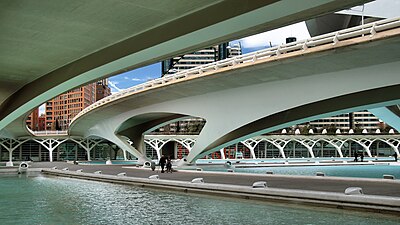
Pont de Montolivet
-

Palau de les Arts Reina Sofía
-

-
Reflections
-

Walkway canopy of L'Umbracle
-
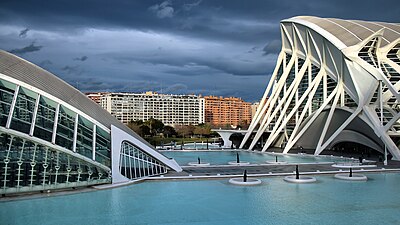
Panoramic
-

-

Metropolis of Arts and Sciences at night
-

Assut de fifty'Or Bridge, Ágora (2014)
-
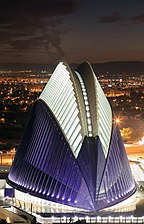
L'Àgora 2010
-

L'Oceanogràfic (2019)
-

Noche Ciudad Artes Ciencias
See also [edit]
- 12 Treasures of Spain
- Culture of Spain
- Tourism in Spain
- Quatre Carreres, home of the Urban center of Arts and Sciences.
References [edit]
- ^ a b "Stop betoken to the City of Arts (in Spanish)". ABC Valencian Community. 2 November 2009. Retrieved one July 2010.
- ^ Suzanne Daley, Santiago Calatrava Collects Critics every bit Well as Fans The New York Times, Sept. 24, 2013
- ^ Ordóñez, José Antonio Fernández. "Puente de Monteolivete". structurae.net . Retrieved 22 June 2020.
- ^ Calatrava, Santiago. "Puente de Monteolivete". structurae.net . Retrieved 22 June 2020.
- ^ "Torres de Valencia , 2005 (Project), by Santiago Calatrava". jmhdezhdez.com . Retrieved 20 July 2020.
- ^ a b Osset, Lucia. "1989: The Antonio X Ros project (in Spanish)". Concluding Degree Projection: Ciudad de las Artes y las Ciencias.
- ^ a b Osset, Lucia. "1991: Santiago Calatrava and Joan Lerma (in Castilian)". Final Degree Project: Ciudad de las Artes y las Ciencias.
- ^ a b "Calatrava considers his fees 'even pocket-sized'". El Pais (in Spanish). 19 June 2012. Retrieved xx July 2020.
...in 1991 this work was deputed to Santiago Calatrava, initially equanimous of three buildings: the Planetarium, the Scientific discipline Museum and the Telecommunications Tower. This complex of three buildings had an expected toll of 300 million euros. In 1996, the regional regime, in addition to changing the Telecommunications Tower for an Opera [House]..., expanded the project with new works and buildings... which represent an additional cost of 800 million euros.
- ^ a b Osset, Lucia. "1995: Santiago Calatrava and the Popular Party (in Castilian)". Last Degree Project: Ciudad de las Artes y las Ciencias.
- ^ a b Tola, Ani; Vokshi, Armand (November 2013). "Santiago Calatrava, City of Arts and Science: The Similarity of the Elements". Briefing: 2d Annual International Conference on Business concern, Technology and Innovation. Durres, Albania. Architecture, Spatial Planning and Civil Engineering: 32–42. doi:10.33107/ubt-ic.2013.iii. ISBN978-9951-437-23-3 . Retrieved 20 July 2020.
- ^ "City of Arts and Sciences". wikiarquitectura . Retrieved 20 July 2020.
- ^ "HISTORY: Ciudad de las Artes y las Ciencias S.A." CAC SA . Retrieved 20 July 2020.
In July 1996, Ciudad de las Artes y las Ciencias, S.A. was founded, following a alter in company name from Vacico (Valencia, Ciencia y Comunicaciones), a trading company run past the Government of Valencia.
- ^ "Metropolis Of Arts And Sciences". Arcspace. August 2012. Retrieved xx July 2020.
- ^ a b "City of Arts and Sciences - Valencia - Santiago Calatrava". spacesXplaces. Oct 2016. Retrieved 20 July 2020.
- ^ Osset, Lucia. "Cost overruns (in Spanish)". Final Caste Project: Ciudad de las Artes y las Ciencias.
- ^ "CHRONOLOGY: Ciudad de las Artes y las Ciencias S.A." CAC SA . Retrieved 20 July 2020.
- ^ "George Clooney's Tomorrowland Exists in Spain". The Huffington Post.
- ^ Webb, Claire (22 April 2017). "Visit Doctor Who's spectacular colony globe… in Valencia". Radio Times . Retrieved 27 January 2020.
- ^ "For Westworld Flavour 3, Los Angeles of 2058 Was Congenital With Input From Bjarke Ingels". Architectural Digest. 2020-03-20.
- ^ https://www.atlasofwonders.com/2020/09/bill-and-ted-house-filming-locations.html October 2020
- ^ "La Ciudad de las Artes aporta 113 millones al PIB". 30 May 2019.
- Tzonis, Alexander. Santiago Calatrava: The Complete Works. New York: Rizzoli, 2004. Print.
- Jodidio, Philip. Santiago Calatrava. Köln: Taschen, 1998. Print.
- Precipitous, Dennis. Santiago Calatrava. London: East & FN SPON, 1994. Print.
External links [edit]
- Official website Ciutat de les Arts i les Ciències
- Official tourism website of Valencia Archived 2016-08-17 at the Wayback Machine
- Ciutat de les Arts i les Ciències at Google Maps
- Architectural photos by Varlamov at flickr
- Photo essay Urban center of Arts and Sciences 2002
Source: https://en.wikipedia.org/wiki/City_of_Arts_and_Sciences
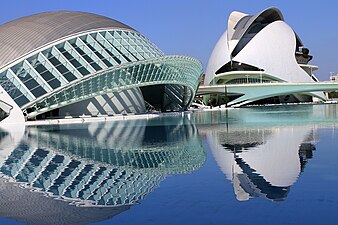
0 Response to "Where Is the City of Arts and Sciences Waht City Is It in"
Post a Comment